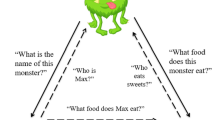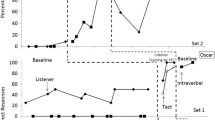Abstract
We examined two methods to facilitate the emergence of untaught intraverbal responses to children with autism. Listener behavior training (LT) involved reinforcement of a selection-based response following presentation of an array of pictures on an iPad® and an auditory instruction describing a characteristic of the picture. Stimulus pairing (SP) involved presentation of one picture in isolation on the iPad® and an auditory instruction describing a characteristic of the picture. Participants were not required to emit an overt vocal response during SP. Results indicate both procedures were effective at producing some untaught intraverbal responses, but a transfer of stimulus control procedure was required for two of the three participants to meet mastery criterion. Results are discussed in terms of necessary prerequisite skills for each procedure, and the requirement of an overt or echoic response to help facilitate the emergence of intraverbals.




Similar content being viewed by others
References
Coon, J. T., & Miguel, C. F. (2012). The role of increased exposure to transfer-of-stimulus-control procedures on the acquisition of intraverbal behavior. Journal of Applied Behavior Analysis, 45, 657–666. doi:10.1901/jaba.2012.45-657.
DeLeon, I. G., & Iwata, B. A. (1996). Evaluation of a multiple-stimulus presentation format for assessing reinforcer preferences. Journal of Applied Behavior Analysis, 29, 519–532. doi:10.1901/jaba.1996.29-519.
Dounavi, A. (2011). A comparison between tact and intraverbal training in the acquisition of a foreign language. European Journal of Behavior Analysis, 12, 239–248.
Eikeseth, S., & Smith, T. (1992). The development of functional and equivalence classes in high-functioning autistic children: The role of naming. Journal of the Experimental Analysis of Behavior, 58, 123–133. doi:10.1901/jeab.1992.58-123.
Fiorile, C. A., & Greer, R. D. (2007). The induction of naming in children with no prior tact responses as a function of multiple exemplar histories of instruction. The Analysis of Verbal Behavior, 23, 71–87.
Greer, R. D., Yuan, L., & Gautreaux, G. (2005). Novel dictation and intraverbal responses as a function of a multiple exemplar instructional history. The Analysis of Verbal Behavior, 21, 99–116.
Horne, P. J., & Lowe, C. F. (1996). On the origins of naming and other symbolic behavior. Journal of the Experimental Analysis of Behavior, 65, 185–241. doi:10.1901/jeab.1996.65-185.
Horne, P. J., Lowe, C. F., & Randle, V. R. L. (2004). Naming and categorization in young children: II. Listener behavior training. Journal of the Experimental Analysis of Behavior, 81, 267–288. doi:10.1901/jeab/2004.81-267.
Ingvarsson, E. T., & Hollobaugh, T. (2011). A comparison of prompting tactics to establish intraverbals in children with autism. Journal of Applied Behavior Analysis, 44, 659–664. doi:10.1901/jaba.2011.44-659.
Keintz, K. S., Miguel, C. F., Kao, B., & Finn, H. E. (2011). Using conditional discrimination training to produce emergent relations between coins and their values in children with autism. Journal of Applied Behavior Analysis, 44, 909–913. doi:10.1901/jaba.2011.44-909.
Leader, G., & Barnes-Holmes, D. (2001a). Matching-to-sample and respondent type training as methods for producing equivalence relations: Isolating the critical variable. The Psychological Record, 51, 429–444.
Leader, G., & Barnes-Holmes, D. (2001b). Establishing fraction-decimal equivalence using a respondent-type training procedure. The Psychological Record, 51, 151–165.
May, R. J., Hawkins, E., & Dymond, S. (2012). Brief report: Effects of tact training on emergent intraverbal vocal responses in adolescents with autism. Journal of Autism and Developmental Disorders, 43, 996–1004. doi:10.1007/s10803-012-1632-7.
Miguel, C. F., Petursdottir, A. I., & Carr, J. E. (2005). The effects of multiple-tact and receptive-discrimination training on the acquisition of intraverbal behavior. The Analysis of Verbal Behavior, 21, 27–41.
Nuzzolo-Gomez, R., & Greer, R. D. (2004). Emergence of untaught mands or tacts of novel adjective-object pairs as a function of instructional history. The Analysis of Verbal Behavior, 20, 63–76.
Partington, J. W., & Bailey, J. S. (1993). Teaching intraverbal behavior to preschool children. The Analysis of Verbal Behavior, 11, 9–18.
Partington, J. W., & Sundberg, M. L. (1998). Assessment of basic language and learning skills (The ABLLS): An assessment for language delayed students. Pleasant Hill: Behavior Analysts.
Petursdottir, A. I., Carr, J. E., Lechago, S. A., & Almason, S. M. (2008a). An evaluation of intraverbal training and listener training for teaching categorization skills. Journal of Applied Behavior Analysis, 41, 53–68.
Petursdottir, A. I., Olafsdottir, A. R., & Aradottir, B. (2008b). The effects of tact and listener training on the emergence of bidirectional intraverbal relations. Journal of Applied Behavior Analysis, 41, 411–415. doi:10.1901/jaba.2008.41-411.
Rosales, R., Rehfeldt, R. A., & Huffman, N. (2012). Examining the utility of the stimulus pairing observation procedure with preschool children learning a second language. Journal of Applied Behavior Analysis, 45, 173–177. doi:10.1901/jaba.2012.45-173.
Sindelar, P. T., Rosenberg, M. S., & Wilson, R. J. (1985). An adapted alternating treatments design for instructional research. Education and Treatment of Children, 8, 67–76.
Skinner, B. F. (1957). Verbal behavior. Englewood Cliffs: Prentice-Hall.
Sundberg, M. L. (2008). Verbal behavior milestones assessment and placement program: The VB-MAPP. Concord: AVB Press.
Sundberg, M. L., & Michael, J. (2001). The benefits of Skinner’s analysis of verbal behavior for children with autism. Behavior Modification, 25, 698–724. doi:10.1177/0145445501255003.
Takahashi, K., Yamamoto, J., & Noro, F. (2011). Stimulus pairing training in children with autism spectrum disorder. Research in Autism Spectrum Disorders, 5, 547–553.
Vendora, J., Meunier, L., & Mackay, H. (2009). Teaching intraverbal behavior to children with autism: A comparison of textual and echoic prompts. The Analysis of Verbal Behavior, 25, 79–86.
Watson, P. J., & Workman, E. A. (1981). The non-concurrent multiple baseline across-individuals design: An extension of the traditional multiple baseline design. Journal of Behavior Therapy and Experimental Psychiatry, 12, 257–259.
Acknowledgments
The first author (MVB) completed this project as a master’s thesis under supervision of the second author to fulfill graduation requirements for the Applied Behavior Analysis program at Youngstown State University. We thank Amanda Gillen and Kristopher Brown for their assistance with reliability data collection.
Author information
Authors and Affiliations
Corresponding author
Rights and permissions
About this article
Cite this article
Vallinger-Brown, M., Rosales, R. An Investigation of Stimulus Pairing and Listener Training to Establish Emergent Intraverbals in Children with Autism. Analysis Verbal Behav 30, 148–159 (2014). https://doi.org/10.1007/s40616-014-0014-y
Published:
Issue Date:
DOI: https://doi.org/10.1007/s40616-014-0014-y




